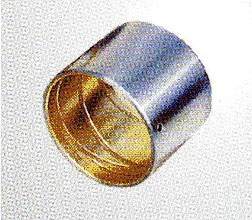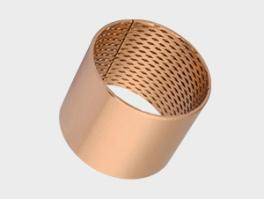Abstract: In order to improve the repair quality of diesel engines and do a good job in the selection and repair of sliding bearings, this article provides a detailed explanation of the performance and characteristics of bearings, and highlights the precautions to be taken when repairing sliding bearings in modern automotive engines.
Keywords: sliding bearings; Diesel engine; Repair quality
1. Performance and characteristics of sliding bearings
In the selection and repair of sliding bearings, it is necessary to have a comprehensive understanding of the performance and characteristics of the bearings. Because bearings made of different materials are suitable for different engines, such as copper lead alloy with hard matrix soft particles and high tin aluminum alloy bearings, which are suitable for high-power and high-speed heavy-duty diesel engines, while white alloy bearings with soft matrix hard particles are mostly used for small and medium-sized engines. The fit clearance of bearings and journals of different materials varies.
(1) Tin based babbitt alloy bearings: Tin based babbitt alloy is an early wear reducing alloy material used in engine bearings. This alloy is a soft matrix hard point material with good wear resistance, embeddedness, and compliance. Its major drawback is its low fatigue strength. Especially when the temperature exceeds 100 ℃, its hardness and strength sharply decrease.
(2) High tin aluminum alloy bearings: The main component of this alloy is aluminum, which accounts for 20% of tin content, so it is also known as 20 tin aluminum alloy. Its structure is evenly distributed with soft particles on a hard substrate, resulting in high load-bearing capacity, high allowable linear speed, good anti adhesion and anti bite performance, and therefore suitable for the requirements of high-speed diesel engines.
(3) Copper lead alloy bearings: Copper lead alloy is a hard matrix of copper evenly distributed with soft lead particles that are not melted in copper. Its outstanding advantages are large load-bearing capacity, good fatigue resistance, and little influence of temperature changes on mechanical properties. It can still work normally even at 250 ℃. However, copper lead alloy bearings have the following drawbacks compared to white alloy bearings: a. Poor compliance and embeddedness. b. Susceptible to acid corrosion, with high requirements for the quality of lubricating oil. c. Copper and lead have a low degree of mutual melting, and can hardly melt at room temperature, resulting in segregation. d. Poor sensitivity to faults. When the engine burns due to lack of oil or improper repair during operation (with varying degrees of adhesion and bite), the high melting point and hardness of copper can cause the surface of the journal to heat up violently and be roughened, blued, annealed, or cracked. The white alloy has softened before melting, and the journal can automatically iron the bite area, so not only will the journal not be damaged, but the bearing can also continue to work without obvious damage. Even if a complete adhesive bite occurs, the white alloy will adhere to the surface of the journal, thereby protecting the journal from damage. Practice has shown that after the accident of burning the bearing pads and holding the shaft in white alloy bearings, there is no obvious strain on the journal, the hardness will not decrease, and quenching cracks will not occur.
(4) Three layer metal bearings: Generally, bearings are composed of two layers of metal, steel back and bearing alloy. In order to improve the surface performance of copper lead alloy and aluminum tin alloy hard matrix soft particle bearings, The method of plating another layer of alloy on the surface of the bearing (with a thickness of 0.02-0.04mm) is adopted to make the bearing a structure of steel back, bearing alloy, and third alloy layer, hence it is called "three layer metal bearing" . The main function of the third alloy layer is to improve the adhesion resistance, compliance, and lipophilicity of hard matrix soft particle bearings, retaining the advantages of hard matrix soft particle alloys and making up for their shortcomings, thus being widely used. The three-layer metal bearing cannot be scraped or polished, otherwise it will lose the function of the third alloy layer and accelerate the wear of the bearing and journal, resulting in a rapid increase in fit clearance.
2. Selection and repair of bearings
Due to its unique structural characteristics, modern automotive engine sliding bearings should pay attention to the following when repairing:
(1) Thin walled bearing shells are not allowed to be repaired. In the past, the crankshaft main bearings and connecting rod bearings of automotive engines had to be scraped when replaced, and only scraping could ensure an ideal contact area. In fact, the wear-resistant alloy coatings on the crankshaft main bearings and connecting rod bearings of modern automotive engines are very thin, with high dimensional accuracy and low surface roughness values. Generally, scraping is not allowed. Can only be selected according to the corresponding size; If there is no suitable size crankshaft bearing, if necessary, the crankshaft can be ground using a base hole method to obtain a suitable fit clearance. In order to adapt to this situation, the method of grinding the journal according to the size of the bearing pad should be adopted, changing the previous method of using the bearing pad for matching. For three-layer alloy bearing shells, the surface alloy layer is covered by electroplating method to improve the surface performance of copper lead alloy bearings. If scraped, this effect will be lost and the original design concept will be destroyed. The previously widely used processes such as scraping and striking tiles should gradually transition towards direct assembly of finished tiles.
(2) After the bearing pads are worn, they should not be padded on the back of the pads. The bearing bush and the bearing seat are two parts that need to work like one part after assembly. As the bearing bush is thin-walled, in order to ensure the correct geometric shape during operation, it depends entirely on the geometric shape of the bearing seat hole. Therefore, the machining accuracy of the two parts is very high, and the surface roughness value is very low. If paper is placed between them, it will inevitably damage their correct fit. At the same time, paper is also a poor conductor of heat, which is not conducive to the heat dissipation of the bearing bush, So the paper pad may also cause the oil temperature in the lubrication system to be too high, and even cause a tile burning accident. Similarly, it is not allowed to place copper sheets under the tile back. In addition, it is not allowed to loosen the bearing pads after assembly, and after padding the pad back, it is easy to loosen, thereby damaging the normal working conditions of the bearing pads.
(3) If there is a locating lip on the back of the bearing shell, it is also necessary to prevent rolling. The bearing pad requires reliable positioning with the bearing pad seat during operation, and it is not allowed to rotate, move, or vibrate. During the overhaul, it was found that the back of the tile was worn very smoothly, indicating that there was looseness. However, the key measure for reliable positioning of bearing shells is the appropriate amount of interference, rather than the role of the positioning lip, which is used for initial positioning during assembly.
3. The free spring potential of the bearings should meet the requirements
To make the bearing easy to assemble and tightly fit with the seat hole, and to prevent the working surface of the bearing cover from shrinking under pressure after tightening, it is necessary to ensure that the free spring of the repaired bearing meets the requirements. Generally, the minimum free spring potential Z of thin-walled bearings is 0.25~0.5mm, and the maximum Z value is 1.20~1.5mm. If the spring potential is too small, it will reduce the adhesion force on the back of the bearing after being installed into the seat hole method. When tightening the bearing cover, it is easy to cause the low-carbon steel metal material on the back of the bearing to slide under pressure and shrink and bulge towards the reducing wear alloy side. The shrinkage and protrusion of bearings can seriously hinder the heat transfer of bearings to the seat hole, easily melting the metal layer, and causing sliding accidents. Of course, too large free elastic potential will also have a negative impact on the reliability and life of the bearing, because the Shear stress at the joint between the antifriction alloy layer and the bearing back increases, which is easy to cause the alloy to peel off at the joint.
More about Epen E90 Bushing:
E90 bronze wrapped bushings are made of entirely bronze CuSn8. Because of material properties, the working surface rolled with diamond Indentations (standard Indentations) or stamped oil grooves according to detailed application. And it also has good performance of anti-corrosion caused by chemical and environments. During the operation, the grease & oil will be released from the indentations, which allow for long-term lubrication. Compare with machined bronze bearings, E90 can offer some advantages including thin wall, lower weight, cheaper cost, high load etc. It is suitable for high load, lower speed application like construction, transport, and agriculture machinery.
http://www.cnepen.com/showinfo-216-559-0.html




